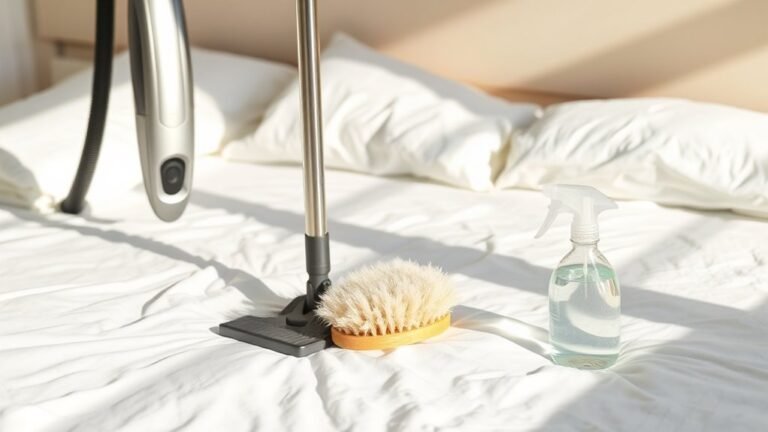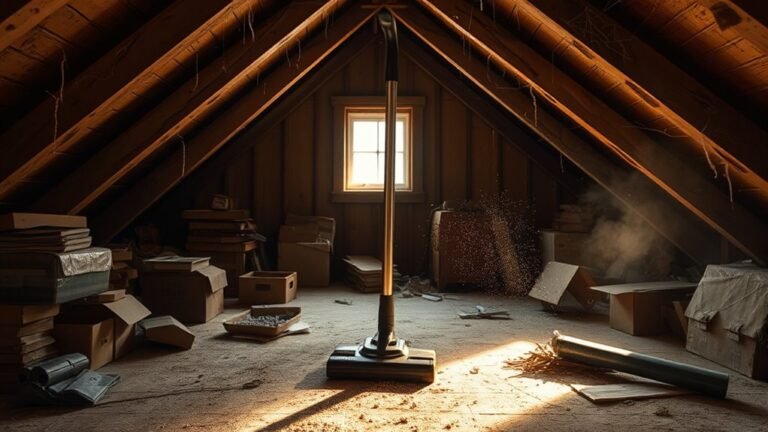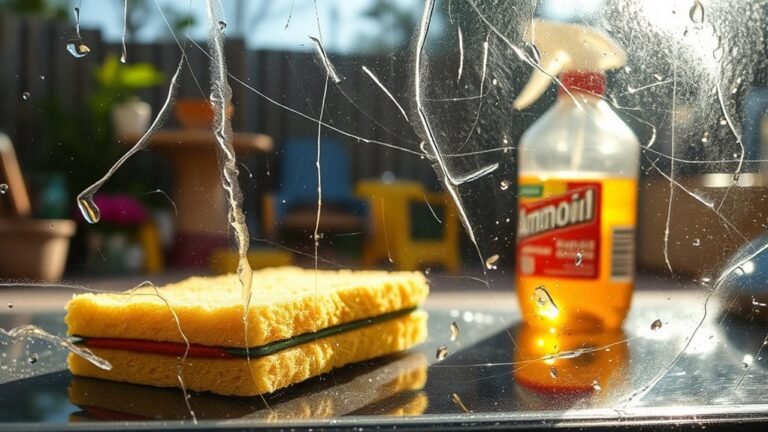Mistakes to Avoid When Cleaning Your Attic
When cleaning your attic, don’t skip safety gear like gloves and masks to avoid injuries and health risks from dust or insulation. Pay attention to structural damage and pest signs to prevent costly repairs. Avoid disturbing insulation unnecessarily, and be sure to declutter and organize for easier access. Also, keep your attic well-ventilated to reduce moisture and odors. If you want to tackle your attic thoroughly and safely, there’s more to contemplate before you start.
Neglecting Proper Safety Gear

Although it might seem like a hassle, neglecting proper safety gear when cleaning your attic can lead to serious injuries. You want to feel free and confident while working, but skipping essential safety equipment puts you at unnecessary risk. Using personal protection like gloves, a dust mask, and goggles shields you from harmful dust, insulation fibers, and potential pests lurking in the dark. You might think you’re saving time by avoiding this gear, but one injury can trap you instead of freeing you. Prioritize your safety equipment before you start; it’s the key to maintaining your independence and freedom while tackling the attic. Don’t let a small oversight compromise your health or your ability to move freely in the future.
Ignoring Structural Issues
When you’re cleaning your attic, don’t overlook any visible damage like cracks or sagging beams. Ignoring water leaks can lead to serious mold problems down the line. Also, keep an eye out for signs of pests that could be damaging the structure without you realizing it.
Identifying Visible Damage
One of the biggest mistakes you can make during attic cleaning is overlooking visible damage that signals structural problems. When you clean your attic, don’t rush—use reliable attic inspection techniques to spot cracks, sagging beams, or warped wood. These signs often point to serious issues that need immediate attention. Following damage assessment guidelines helps you determine which problems you can handle and when to call a pro. Remember, ignoring visible damage limits your freedom, as structural issues can worsen, leading to costly repairs or safety hazards. Take control by thoroughly inspecting every corner, so you can address problems early and keep your attic safe and sound. Your freedom depends on recognizing these warning signs before they escalate.
Ignoring Water Leaks
Many attic problems begin with water leaks, yet you might not realize their impact until damage becomes severe. Ignoring water leaks can lead to costly repairs and compromise your home’s safety. To avoid this, prioritize early leak detection and address issues promptly. Watch out for:
- Dark stains or discoloration on wood and insulation
- Musty odors signaling hidden moisture
- Warped or sagging ceiling panels
- Dripping sounds or visible water puddles
Ignoring these signs invites water damage that weakens structural integrity and encourages mold growth. By staying vigilant, you keep your attic dry and your home secure, preserving your freedom from unexpected expenses and health risks. Don’t let a small leak steal your peace of mind—spot it early and act fast.
Overlooking Pest Infestations
If you overlook pest infestations, you could be ignoring serious structural issues that threaten your attic’s stability. Pests like termites, rodents, or carpenter ants can quietly damage wooden beams and insulation, compromising your home’s safety. Don’t wait until damage is visible—know the signs infestations leave behind, such as droppings, gnaw marks, or unusual noises. Taking a proactive approach with regular pest control checks frees you from unexpected problems and costly repairs. When cleaning, inspect thoroughly and act promptly if you spot any signs. By staying vigilant, you maintain your attic’s integrity and protect your freedom from expensive, invasive damage. Remember, tackling infestations early is the key to preserving both your home and peace of mind.
Overlooking Pest Infestations
Although it’s tempting to rush through attic cleaning, you shouldn’t ignore signs of pest infestations. Spotting these early lets you protect your space and maintain your freedom from unwanted guests. Focus on pest identification by watching for:
- Droppings or urine stains
- Gnaw marks on wood or wiring
- Nests made from shredded materials
- Unusual odors or sounds
Ignoring infestation signs can lead to costly damage and health risks. When you clean, take the time to inspect thoroughly. Don’t let pests take control—spotting them early means you can act fast and keep your attic a safe, clean place where your belongings stay protected and your mind at ease.
Mishandling or Disturbing Insulation

When cleaning your attic, you need to handle insulation carefully to avoid health risks like irritation or respiratory issues. Disturbing insulation without proper protection can release harmful particles into the air. Make sure you follow safe handling and disposal methods to protect yourself and maintain your home’s safety.
Proper Insulation Handling Techniques
Since attic insulation can contain irritants like fiberglass or mineral wool, mishandling it may cause skin irritation, respiratory issues, or damage to the insulation’s effectiveness. To keep your attic safe and energy-efficient, follow proper insulation handling techniques. Respect the insulation materials and the installation techniques used to maintain their function.
Here’s what you can do:
- Wear protective gear like gloves, goggles, and a mask to avoid irritation.
- Avoid compressing or disturbing the insulation to preserve its insulating properties.
- Use gentle, non-invasive cleaning methods around insulation areas.
- Seal any gaps or damage carefully without removing or moving insulation layers.
Health Risks of Disturbance
If you mishandle or disturb attic insulation, you could expose yourself to harmful particles that cause skin irritation, respiratory problems, and allergic reactions. Mold exposure hidden in insulation worsens respiratory issues if disturbed. Protect your freedom by understanding these risks before you start.
| Risk Type | Potential Effects |
|---|---|
| Skin Irritation | Itching, redness, rashes |
| Respiratory Issues | Coughing, wheezing, difficulty breathing |
| Allergic Reactions | Sneezing, watery eyes, congestion |
| Mold Exposure | Chronic respiratory illnesses |
Don’t let careless handling trap you in health problems. Use proper gear and avoid stirring up dust and mold to keep your airways clear and your skin safe. Your health is your freedom—guard it wisely.
Safe Disposal Methods
Although handling attic insulation can be tricky, knowing how to dispose of it safely is crucial to protect yourself and your home. Mishandling insulation can release hazardous waste, so you want to avoid disturbing it unnecessarily. Here’s how to handle disposal responsibly:
- Wear protective gear to prevent exposure to harmful fibers.
- Separate insulation materials from general waste to facilitate recycling materials.
- Check local regulations for disposing of hazardous waste to avoid fines.
- Use designated collection sites or professional services to guarantee safe disposal.
Failing to Organize and Declutter

Anyone tackling attic cleaning knows that skipping the organization and decluttering step can turn the process into a frustrating mess. If you want to regain control and freedom over your space, you need to embrace effective decluttering methods. Start by sorting items into keep, donate, or toss piles. This clears out what no longer serves you, making your attic easier to navigate. Use organization tips like labeling boxes and grouping similar items together to maintain order. Without a clear plan, your attic will quickly become a chaotic storage area, limiting your ability to use the space freely. Taking the time to organize and declutter guarantees your attic becomes a functional, stress-free zone you can truly enjoy.
Not Ventilating the Space Adequately
When you neglect proper ventilation in your attic, moisture can build up quickly, leading to mold growth and wood rot. Without adequate attic ventilation, stale air lingers, creating an unhealthy environment and threatening your home’s structure. To keep your attic fresh and dry, focus on improving air circulation by:
- Installing vents to promote airflow
- Using fans to boost ventilation during cleaning
- Keeping vents clear of debris and insulation
- Checking for and sealing air leaks to balance airflow
Frequently Asked Questions
How Often Should I Clean My Attic?
Think of your attic like a trusty ship that needs regular care to sail smoothly. You should clean it at least twice a year, aligning with a seasonal cleaning schedule to keep clutter at bay. Following attic organization tips, like sorting items and labeling boxes, helps you navigate freedom from chaos. This way, your attic remains a treasure trove, not a stormy sea, giving you space to breathe and store with ease.
What Cleaning Supplies Are Best for Attic Dust?
When tackling attic dust removal, you’ll want to gear up with the right safety gear—think a dust mask, gloves, and goggles to keep yourself protected. Use a vacuum with a HEPA filter to trap fine dust effectively, and microfiber cloths to wipe surfaces without spreading particles around. These supplies help you clean efficiently while keeping your freedom to breathe easy and move safely through your attic space.
Can I Use a Regular Vacuum in the Attic?
Did you know that 90% of attic dust is made up of tiny insulation particles? So, when you’re cleaning your attic, using a regular vacuum might not be the best move—it can damage your attic insulation or clog quickly. Instead, look for vacuum options with HEPA filters or specialized attachments designed for delicate spaces. This way, you’ll protect your home’s energy efficiency and enjoy the freedom of a cleaner, safer attic.
How Do I Safely Dispose of Old Attic Materials?
When you’re ready to clear out old attic materials, start by sorting everything using attic organization tips—keep what’s valuable and toss what’s not. For anything hazardous, like old insulation or chemicals, never just throw it in the trash. Instead, check your local hazardous material disposal guidelines to keep yourself and the environment safe. This way, you’ll free up space and feel great about responsibly clearing out your attic.
Should I Hire a Professional for Attic Cleaning?
Think of attic cleaning like traversing a mysterious attic in a classic adventure tale—you want to avoid hidden dangers. If you value attic safety and your freedom from hassle, hiring professional services is a smart move. Pros have the right gear and expertise to handle insulation, pests, and debris safely. This way, you can relax knowing the job’s done right without risking injury or damage, freeing you up for what you love.






